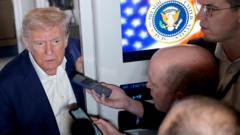The article text:
In a bold policy shift, the Trump administration has recently exempted certain electronic devices, such as smartphones and computers, from substantial tariffs applied to Chinese imports. The announcement from US Customs and Border Protection reveals a significant easing of pressure on the tech industry, with the 125% tariffs on Chinese electronics being notably excluded from Trump's newly instated 10% global tariff.
During a flight to Miami over the weekend, President Trump hinted at providing more details about these exemptions early next week, expressing confidence in the financial benefits the tariffs have been generating for the country. "We're taking in a lot of money," he stated while assuring that the goods are exempt from any comprehensive nonspecific tariffs presently in place.
The decision came as a response to increasing apprehensions voiced by US tech companies concerning possible price hikes for gadgets, given that a majority of such products originate from China. Among the items exempted are not only smartphones but also critical components, including semiconductors and solar cells. Dan Ives, a leading tech analyst, termed the exemption as a "dream scenario" for technology investors, especially benefiting major firms like Apple, Nvidia, and Microsoft.
The White House emphasized that these exemptions are designed to provide companies adequate time to relocate production within the US. In a statement by Press Secretary Karoline Leavitt, the administration underscored the need for a self-sufficient manufacturing base for essential technology.
Although President Trump has expressed satisfaction with the existing high tariffs on Chinese imports, hinting at potential benefits from them, the electronic devices still remain subject to certain tariffs, specifically a 20% charge tied to China's fentanyl exports.
Reports indicate that if the proposed tariffs had proceeded, the cost of items such as iPhones could have surged, with estimates suggesting price increases of up to threefold. The US market plays a crucial role in Apple's business, as the company accounted for over half of smartphone sales last year, with the majority of its production crafted in China. In recent times, Apple has accelerated efforts to diversify its supply chains, looking to countries like India and Vietnam to reduce dependence on Chinese manufacturing.
Initially, President Trump laid out plans for a set of steep tariffs against various global partners. However, these plans took a new trajectory when he announced a 90-day suspension for countries unaffected by retaliatory tariffs, while imposing a hefty increase for China. Trump's newfound tactic appears to be a strategy to negotiate more favorable conditions in international trade discussions.
His administration asserts that these import taxes are aimed not only at rectifying perceived imbalances in the global trading framework but also at revitalizing American jobs and factories. As stakeholders across various sectors scrutinize the evolving tariff landscape, key questions arise regarding the tangible impacts on consumer prices and the broader market dynamics.
In a bold policy shift, the Trump administration has recently exempted certain electronic devices, such as smartphones and computers, from substantial tariffs applied to Chinese imports. The announcement from US Customs and Border Protection reveals a significant easing of pressure on the tech industry, with the 125% tariffs on Chinese electronics being notably excluded from Trump's newly instated 10% global tariff.
During a flight to Miami over the weekend, President Trump hinted at providing more details about these exemptions early next week, expressing confidence in the financial benefits the tariffs have been generating for the country. "We're taking in a lot of money," he stated while assuring that the goods are exempt from any comprehensive nonspecific tariffs presently in place.
The decision came as a response to increasing apprehensions voiced by US tech companies concerning possible price hikes for gadgets, given that a majority of such products originate from China. Among the items exempted are not only smartphones but also critical components, including semiconductors and solar cells. Dan Ives, a leading tech analyst, termed the exemption as a "dream scenario" for technology investors, especially benefiting major firms like Apple, Nvidia, and Microsoft.
The White House emphasized that these exemptions are designed to provide companies adequate time to relocate production within the US. In a statement by Press Secretary Karoline Leavitt, the administration underscored the need for a self-sufficient manufacturing base for essential technology.
Although President Trump has expressed satisfaction with the existing high tariffs on Chinese imports, hinting at potential benefits from them, the electronic devices still remain subject to certain tariffs, specifically a 20% charge tied to China's fentanyl exports.
Reports indicate that if the proposed tariffs had proceeded, the cost of items such as iPhones could have surged, with estimates suggesting price increases of up to threefold. The US market plays a crucial role in Apple's business, as the company accounted for over half of smartphone sales last year, with the majority of its production crafted in China. In recent times, Apple has accelerated efforts to diversify its supply chains, looking to countries like India and Vietnam to reduce dependence on Chinese manufacturing.
Initially, President Trump laid out plans for a set of steep tariffs against various global partners. However, these plans took a new trajectory when he announced a 90-day suspension for countries unaffected by retaliatory tariffs, while imposing a hefty increase for China. Trump's newfound tactic appears to be a strategy to negotiate more favorable conditions in international trade discussions.
His administration asserts that these import taxes are aimed not only at rectifying perceived imbalances in the global trading framework but also at revitalizing American jobs and factories. As stakeholders across various sectors scrutinize the evolving tariff landscape, key questions arise regarding the tangible impacts on consumer prices and the broader market dynamics.





















